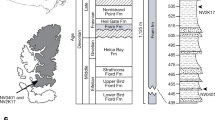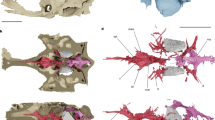Abstract
Among the morphological changes that occurred during the ‘fish-to-tetrapod’ transition was a marked reorganization of the cranial endoskeleton. Details of this transition, including the sequence of character acquisition, have not been evident from the fossil record. Here we describe the braincase, palatoquadrate and branchial skeleton of Tiktaalik roseae, the Late Devonian sarcopterygian fish most closely related to tetrapods. Although retaining a primitive configuration in many respects, the cranial endoskeleton of T. roseae shares derived features with tetrapods such as a large basal articulation and a flat, horizontally oriented entopterygoid. Other features in T. roseae, like the short, straight hyomandibula, show morphology intermediate between the condition observed in more primitive fish and that observed in tetrapods. The combination of characters in T. roseae helps to resolve the relative timing of modifications in the cranial endoskeleton. The sequence of modifications suggests changes in head mobility and intracranial kinesis that have ramifications for the origin of vertebrate terrestriality.
This is a preview of subscription content, access via your institution
Access options
Subscribe to this journal
Receive 51 print issues and online access
$199.00 per year
only $3.90 per issue
Buy this article
- Purchase on Springer Link
- Instant access to full article PDF
Prices may be subject to local taxes which are calculated during checkout






Similar content being viewed by others
References
Vorobyeva, E. I. Observations on two rhipidistian fishes from the Upper Devonian of Lode, Latvia. Zool. J. Linn. Soc. 70, 191–201 (1980)
Vorobyeva, E. I. & Schultze, H.-P. in Origins of the Higher Groups of Tetrapods (eds Schultze, H.-P. & Trueb, L.) 68–109 (Cornell Univ. Press, 1991)
Schultze, H.-P. & Arsenault, M. The panderichthyid fish Elpistostege: A close relative of tetrapods? Palaeontology 28, 292–309 (1985)
Schultze, H.-P. in Devonian Fishes and Plants of Miguasha, Quebec, Canada (eds Schultze, H.-P. & Cloutier, R.) 316–327 (Verlag Dr. Friedrich Pfeil, 1996)
Daeschler, E. B., Shubin, N. H. & Jenkins, F. A. A Devonian tetrapod-like fish and the evolution of the tetrapod body plan. Nature 440, 757–763 (2006)
Shubin, N. H., Daeschler, E. B. & Jenkins, F. A. The pectoral fin of Tiktaalik roseae and the origin of the tetrapod limb. Nature 440, 764–771 (2006)
Ahlberg, P. E. & Johanson, Z. Osteolepiforms and the ancestry of tetrapods. Nature 395, 792–794 (1998)
Long, J. A., Young, G. C., Holland, T., Senden, T. J. & Fitzgerald, E. M. G. An exceptional Devonian fish from Australia sheds light on tetrapod origins. Nature 444, 199–202 (2006)
Ahlberg, P. E., Clack, J. A., Lukševičs, E., Blom, H. & Zupinš, I. Ventastega curonica and the origin of tetrapod morphology. Nature 453, 1199–1204 (2008)
Ahlberg, P. E., Clack, J. A. & Lukševičs, E. Rapid braincase evolution between Panderichthys and the earliest tetrapods. Nature 381, 61–64 (1996)
Clack, J. A. The Origin of Tetrapods. in Amphibian Biology Vol. 4 (eds Heatwole, H. & Carroll, R.) 979–1029 (Surrey Beatty and Sons, 2000)
Clack, J. A. Acanthostega gunnari, a Devonian tetrapod from Greenland; the snout, palate, and ventral parts of the braincase, with a discussion of their significance. Meddelelser Grønland Geosci. 31, 1–24 (1994)
Clack, J. A. The neurocranium of Acanthostega gunnari Jarvik and the evolution of the otic region in tetrapods. Zool. J. Linn. Soc. 122, 61–97 (1998)
Brazeau, M. D. & Ahlberg, P. E. Tetrapod-like middle ear architecture in a Devonian fish. Nature 439, 318–321 (2006)
Jarvik, E. Basic Structure and Evolution of Vertebrates Vol. 1 (Academic, 1980)
Smithson, T. R. & Thomson, K. S. The hyomandibular of Eusthenopteron foordi Whiteaves (Pisces: Crossopterygii) and the early evolution of the tetrapod stapes. Zool. J. Linn. Soc. 74, 93–103 (1982)
Romer, A. S. The braincase of the Carboniferous crossopterygian Megalichthys nitidus . Bull. Mus. Comp. Zool. 82, 1–73 (1937)
Romer, A. S. Notes on the crossopterygian hyomandibular and braincase. J. Morphol. 69, 141–180 (1941)
Fox, R. C., Campbell, K. S. W., Barwick, R. E. & Long, J. A. A new osteolepiform from the Lower Carboniferous Raymond Formation, Drummond Basin, Queensland. Mem. Queensl. Mus. 38, 97–221 (1995)
Long, J. A., Barwick, R. E. & Campbell, K. S. W. Osteology and functional morphology of the osteolepiform fish Gogonasus andrewsae Long, 1985, from the Upper Devonian Gogo Formation, Western Australia. Rec. West. Aus. Mus. 53 (suppl.). 1–89 (1997)
Johanson, Z., Ahlberg, P. & Ritchie, A. The braincase and palate of the tetrapodomorph sarcopterygian Mandageria fairfaxi: morphological variability near the fish-tetrapod transition. Palaeontology 46, 271–293 (2003)
Thomson, K. S. The endocranium and associated structures in the Middle Devonian rhipidistian fish Osteolepis . Proc. Linn. Soc. Lond. Zool. 176, 181–195 (1965)
Lebedev, O. A. Morphology of a new osteolepidid fish from Russia. Bull. Mus. Natl. Hist. Nat. Paris 17, 287–341 (1995)
Johanson, Z. & Ahlberg, P. E. A new tristichopterid (Osteolepiformes: Sarcopterygii) from the Mandagery Sandstone (Late Devonian, Famennian) near Canowindra, NSW, Australia. Trans. R. Soc. Edinb. 88, 39–68 (1997)
Coates, M. I. & Clack, J. Fish-like gills and breathing in the earliest known tetrapod. Nature 352, 234–236 (1991)
Clack, J. A. Earliest known tetrapod braincase and the evolution of the stapes and fenestra ovalis. Nature 369, 392–394 (1994)
Clack, J. A. Discovery of the earliest-known tetrapod stapes. Nature 342, 425–427 (1989)
Thomson, K. S. T. Mechanisms of intracranial kinetics in fossil rhipidistian fishes (Crosspoterygii) and their relatives. Zool. J. Linn. Soc. 46, 223–253 (1967)
Carroll, R. L. in The Terrestrial Environment and the Origin of Land Vertebrates (ed. Panchen, A. L.) 293–317 (Academic, 1980)
Clack, J. A. Pattern and processes in the early evolution of the tetrapod ear. J. Neurobiol. 53, 251–264 (2002)
Clack, J. A. in The Evolutionary Biology of Hearing (eds Webster, D. B., Ray, R. R. & Popper, A. N.) 405–420 (Springer, 1996)
Acknowledgements
The illustrations are the work of K. Monoyios. Specimen preparation was performed by C. F. Mullison. This research was made possible by permits from the Nunavut Ministry of Culture, Languages, Elders and Youth, the Grise Fiord Hamlet and HTA, with logistical support from the Polar Continental Shelf Project and collections support from the Canadian Museum of Nature. M. Brazeau improved interpretation of P. rhombolepis and offered input. Assistance in the field (1999–2006) was provided by W. Amaral, B. Atagootak, J. Conrad, M. Davis, S. Gatesy, A. Gillis, B. Kilbourne, S. Madsen, K. Middleton, J. Miller, K. Monoyios, C. Schaff, M. Shapiro, R. Shearman and C. Sullivan. This research was supported by an anonymous donor, the Academy of Natural Sciences of Philadelphia, the Putnam Expeditionary Fund (Harvard University), the University of Chicago, the National Science Foundation, and the National Geographic Society Committee for Research and Exploration.
Author information
Authors and Affiliations
Corresponding authors
Supplementary information
Supplementary Information
This file contains Supplementary Figures 1-7 with Legends (PDF 1184 kb)
Rights and permissions
About this article
Cite this article
Downs, J., Daeschler, E., Jenkins, F. et al. The cranial endoskeleton of Tiktaalik roseae. Nature 455, 925–929 (2008). https://doi.org/10.1038/nature07189
Received:
Accepted:
Issue Date:
DOI: https://doi.org/10.1038/nature07189
This article is cited by
-
GESCHMACKSnerv & MusikGESCHMACK
MMW - Fortschritte der Medizin (2023)
-
The rapid evolution of lungfish durophagy
Nature Communications (2022)
-
Elpistostege and the origin of the vertebrate hand
Nature (2020)
-
Morphology of the earliest reconstructable tetrapod Parmastega aelidae
Nature (2019)
-
Tetrapod trackways from the early Middle Devonian period of Poland
Nature (2010)
Comments
By submitting a comment you agree to abide by our Terms and Community Guidelines. If you find something abusive or that does not comply with our terms or guidelines please flag it as inappropriate.



